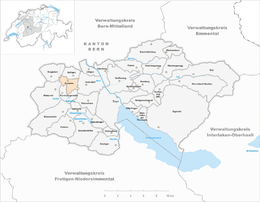Gurzelen
| Gurzelen | ||
|---|---|---|
|
||
| Coordinates: 46°47′N 7°32′E / 46.783°N 7.533°ECoordinates: 46°47′N 7°32′E / 46.783°N 7.533°E | ||
| Country | Switzerland | |
| Canton | Bern | |
| District | Thun | |
| Area | ||
| • Total | 4.54 km2 (1.75 sq mi) | |
| Elevation | 591 m (1,939 ft) | |
| Population (Dec 2015) | ||
| • Total | 855 | |
| • Density | 190/km2 (490/sq mi) | |
| Postal code | 3663 | |
| SFOS number | 0867 | |
| Surrounded by | Burgistein, Forst, Längenbühl, Seftigen, Uetendorf, Wattenwil | |
| Website |
www SFSO statistics |
|
Gurzelen is a municipality in the administrative district of Thun in the canton of Bern in Switzerland.
Gurzelen is first mentioned in 1230/31 as Gurcellun.
The oldest traces of a settlement in the area are individual neolithic artifacts which were found scattered around the municipality. Hallstatt tombs and a Roman era settlement provide evidence of further inhabitants. By the High Middle Ages the village and surround farmland was owned by a local noble. In the 13th century the estate was divided in half, each with its own village, church and castle. Obergurzelen had a church, a fortified tower and a village. Obergurzelen's tower appears in historical records from 1254 until 1353. Niedergurzelen had another church and a castle, known as the Gesäss, which was first mentioned in 1338. The two halves passed through several noble families, before being reunited and then divided again, this time into three portions. After passing through several additional owners, in 1542 the ownership stabilized for two and a half centuries. The von Wattenwyl zu Burgistein family owned two-thirds of the municipality while the city of Bern owned the rest. Over the centuries both the tower and castle fell into ruin and were abandoned. In 1664 the nearby municipality of Seftigen joined the Gurzelen parish. A new church was built in 1710 and the chapel in Obergurzelen was abandoned and demolished. In 1717 the von Graffenried family acquired the Wattenwyl estates, but the two-third split remained. Following the 1798 French invasion, and the creation of the Helvetic Republic the old order was abolished and the three sections were united into the municipality of Gurzelen.
In 1902 the Gürbetal railroad (now part of the BLS) built a station in Gurzelen. While the railroad opened up the municipality, today it is still very rural and agrarian. About two-thirds of the labor force commutes to jobs in Bern and Thun.
...
Wikipedia




